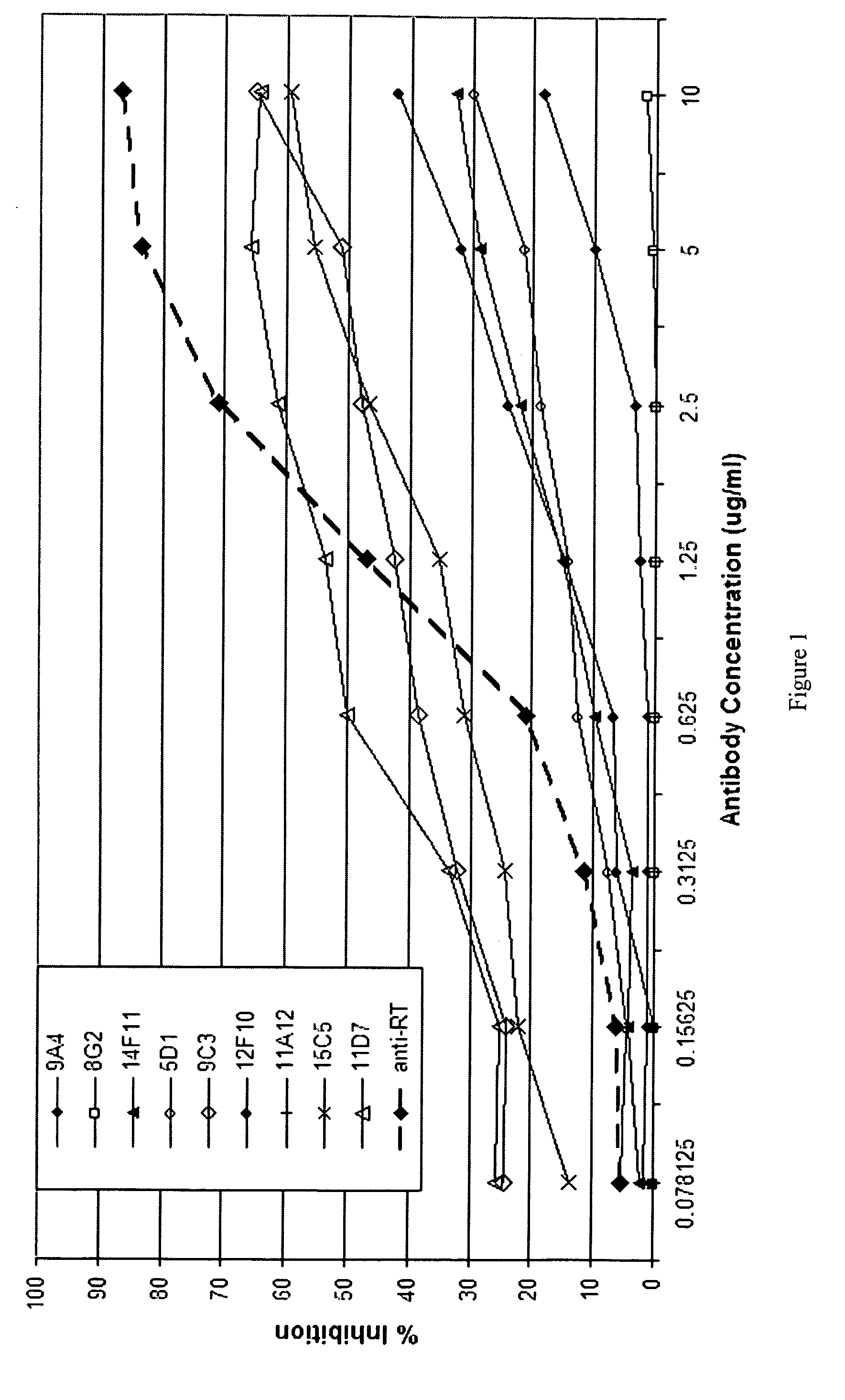Monoclonal antibodies against ricin toxin and methods of making and using thereof
a monoclonal antibody and ricin toxin technology, applied in the field of ricin toxin, can solve the problems of ricin being a very toxic protein, and ricin being a very toxic protein, and inevitably dying cells
- Summary
- Abstract
- Description
- Claims
- Application Information
AI Technical Summary
Benefits of technology
Problems solved by technology
Method used
Image
Examples
example 1
Immunizations
[0115] Male Balb / c mice, about 3 to about 5 weeks old, were purchased from the National Cancer Institute Frederick Cancer Research Facility (NCI-FCRC), Frederick Md. Purified RTA (Lot #39H4053) and RTB (Lot #64H4084) were purchased from Sigma Chemical Co., St. Louis, Mo. Ricin toxin (Lot #9234) was purchased from Inland Chemical Co., Inland, Tex. Ricin communes agglutinin I (RCA 120) was purchased from Vector Laboratories, Burlingame, Calif.
[0116] Mice were primed intraperitoneally (i.p.) with 0.01 μg antigen diluted in phosphate-buffered saline (PBS, pH 7.4, Invitrogen, Carlsbad, Calif.) and emulsified in an equal volume of complete Freund's Adjuvant (BD Biosciences, Sparks, Md.). At two week intervals, the mice were injected i.p. with the following amounts of antigen, emulsified in an equal volume of incomplete Freund's Adjuvant (BD Biosciences, Sparks, Md.): 0.1 μg, 1.0 μg, 10 μg. Two weeks after the last inoculation, serum samples from the mice were evaluated by e...
example 2
Cell Fusions
[0117] Single-cell suspensions, prepared from spleens that had been aseptically removed from immunized mice, were fused with P3X63Ag8.653 myeloma cells (CRL-158-0, American Type Culture Collection, Manassas, Va.) at a 1:2 ratio in 50% (v / v) polyethylene glycol 1500 MW (Boehringer-Mannheim, Indianapolis, Ind.) using methods known in the art. The fused cells were plated in a 96-well microdilution plate and cultured in. OptiMEM medium (Invitrogen, Carlsbad, Calif.) containing hypoxanthine, aminopterin, and thymidine (Boehringer-Mannheim) for 14 days to select for antibody producing cells. The cells were cloned by limiting dilution and then the clones were individually expanded. During the cloning procedure, samples of the culture medium were removed and used to screen for the presence of ricin-specific antibody. Clones positive for antibody to ricin were selected for an additional cycle of cloning by limiting dilution and screening prior to expansion.
example 3
Antibody Screening
[0118] Samples of culture fluid from each well were screened for the presence of Mabs specific for either holotoxin, RTA, and RTB. Antigen (100 ng / well) was coated onto 96-well U-bottom polyvinyl microtiter plates (BD Biosciences) and incubated 17 hours at 4° C. The plates were washed in PBS containing 0.05% Tween 20 (Sigma) and then blocked for 1 hour with PBS containing 1% bovine serum albumin (BSA, Sigma). The culture fluid was serially diluted 5-fold in PBS+1% BSA and incubated for 2 hours at room temperature. After washing with PBS+1% Tween, the plates were incubated for 2 hours at room temperature with phosphatase-labeled goat anti-mouse IgG (Kirkegaard & Perry Laboratories, Gaithersburg, Md.) diluted 1:250 in PBS+1% BSA. The plates were washed with PBS+1% Tween and developed at room temperature using liquid phosphatase substrate (Sigma, St. Louis, Mo.). The A405 of each well was determined using a microplate reader (Molecular Devices, Sunnyvale, Calif.).
PUM
| Property | Measurement | Unit |
|---|---|---|
| Cytotoxicity | aaaaa | aaaaa |
Abstract
Description
Claims
Application Information
 Login to View More
Login to View More - R&D
- Intellectual Property
- Life Sciences
- Materials
- Tech Scout
- Unparalleled Data Quality
- Higher Quality Content
- 60% Fewer Hallucinations
Browse by: Latest US Patents, China's latest patents, Technical Efficacy Thesaurus, Application Domain, Technology Topic, Popular Technical Reports.
© 2025 PatSnap. All rights reserved.Legal|Privacy policy|Modern Slavery Act Transparency Statement|Sitemap|About US| Contact US: help@patsnap.com

